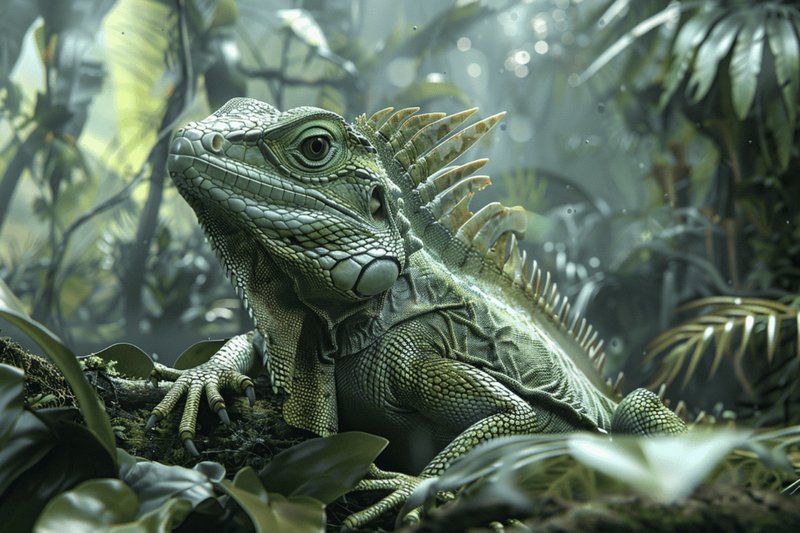
You might be wondering how this unique lizard manages to live where others might struggle. To put it simply, it’s all about adaptation. The basilisk lizard has evolved some extraordinary features to help it navigate the challenges of its habitat. Let’s dive deeper to explore the fascinating ways this lizard not only survives but thrives in harsh environments.
Understanding the Basilisk Lizard’s Habitat
The basilisk lizard is mainly found in Central and South America. It prefers areas near water—think streams, rivers, and wetlands. Why water? Well, it’s all about having access to food and a place to escape predators. Imagine you’re on a treasure hunt: the more clues you have, the easier it is to find your way. For the basilisk, its habitat is filled with tasty insects and plants, while water gives it a safe escape route.
However, life near water can be tricky. Rainforests can be humid, and temperatures can soar. When the sun beats down, it can get boiling hot! The lizard’s environment is often a balancing act between finding food and staying cool. But the basilisk is well-equipped for this challenge, sporting a few clever adaptations that help it manage both food and climate.
Physical Adaptations: Nature’s Ingenious Solutions
One of the basilisk lizard’s most notable features is its unique feet. The lizard has long toes with flaps of skin that help it “run” on the surface of the water. This doesn’t mean it just walks around like a human would. Instead, it pushes off the water quickly, creating small ripples as it goes. Picture a well-timed jump on a trampoline; the faster you push off, the higher you go. The basilisk uses this concept to escape predators and quickly get from one side of the river to another.
Additionally, its coloration plays a role. The green basilisk is bright and vibrant, which helps it blend in with the foliage. Imagine wearing camo in the middle of a party—it’s not about hiding from friends but staying away from those who might cause trouble. This ability to camouflage keeps it safe from hungry eyes looking for a snack.
Behavioral Adaptations: Smart Survival Tactics
Basilisk lizards are not just physical marvels; they’re clever too! They can often be seen basking in the sun to warm themselves up, as they’re cold-blooded. This means they rely on external heat sources to get moving. Think of them like your phone—when it’s too cold, it doesn’t work well, right? The lizard uses the sun’s warmth to stay active and hunt for insects, ensuring it gets enough energy to thrive.
Another interesting behavior is how they interact with their surroundings. These lizards are known for their territorial nature. They often showcase their strength with head bobs and push-ups to ward off other males. It’s like a dance-off—only the strongest gets to claim the best territory! This social behavior ensures they have enough space for feeding and breeding.
Diet and Hunting Strategies
When it comes to meals, the basilisk lizard isn’t picky. They primarily eat insects, fruit, and small animals. Imagine being at an all-you-can-eat buffet where you can pick whatever you like—life is good! The basilisk is opportunistic; it waits for the right moment to catch its prey, often using its agility and speed to nab a meal.
Their unique hunting strategy involves a mix of stealth and speed. They can quietly stalk their prey before bursting into action. Picture a cat creeping up on its favorite toy—it’s all about being calculated and quick. Plus, when food is scarce, these lizards can adjust their diet to include more fruit, showcasing their adaptability in finding nourishment in tough times.
Environmental Challenges: Coping with Change
Despite being well-adapted, basilisk lizards still face significant challenges. Habitat destruction is a major threat as humans clear land for agriculture or urban development. It’s like a restaurant suddenly shutting down; where do the customers go? These lizards are losing their homes, which puts their survival at risk.
Climate change is another issue. Rising temperatures and unpredictable weather patterns can alter their habitats drastically. For instance, heavy rainfall can flood areas where these lizards thrive, while droughts can dry up their beloved water sources. These changes impact their ability to find food and evade predators. The basilisk lizard must continuously adapt to these new challenges, which can be quite the balancing act.
Conservation and Future of the Basilisk Lizard
With all these challenges, you might be wondering what’s being done to help the basilisk lizard. Conservation efforts focus on protecting their natural habitats and educating people about the importance of preserving biodiversity. It’s like having a club that helps each other out—when we support the environment, we ensure that all creatures, including the basilisk, get to thrive.
Also, scientists study these lizards to learn more about their adaptations. By understanding how they survive in harsh conditions, researchers can develop strategies to protect other vulnerable species facing climate change. The basilisk lizard serves as a reminder of how resilient nature can be, even in the face of adversity.
The basilisk lizard is truly a marvel of the animal kingdom. Its incredible adaptations allow it to navigate and survive in some of the harshest environments. From running across water to finding food in changing habitats, this little lizard has mastered the art of survival.
As we continue to learn about these fascinating creatures, it’s crucial to remember the importance of conservation. Protecting their environment not only ensures the future of the basilisk lizard but also helps maintain the delicate balance of our ecosystems. So, the next time you hear about this remarkable lizard, you’ll know just how extraordinary its survival story really is.

